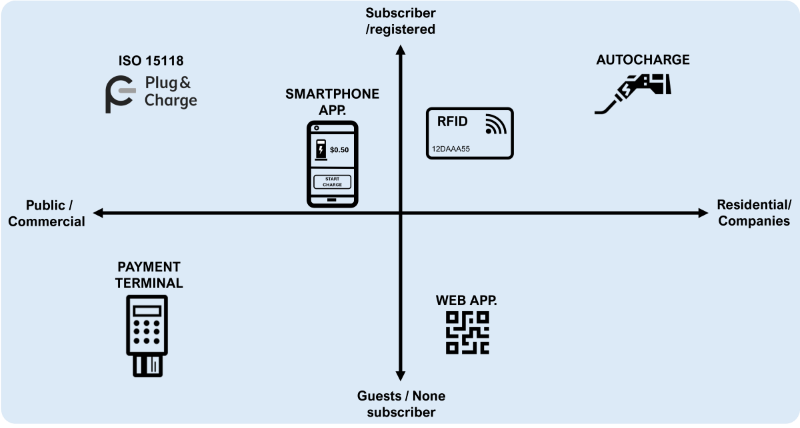There are multiple ways to charge an electric vehicle, but unless you’re using a charger in your home garage, you’ll need an access control method to initiate a charging transaction. They are known as ISO 15118 Plug & Charge, smartphone apps, web apps, RFID technology, payment terminals, and Autocharge. The question arises: How do they function and which one should we choose? The objective of this post is to determine the optimal charging access method, whether you’re utilizing a public (commercial), semi-public (fleet), or private (apartment) charging station.
What are these access methods and how do they work?
EV charging access methods encompass the technologies used to identify a driver and initiate a charging transaction, aimed at authorizing and invoicing EV drivers. These methods often utilize physical means such as RFID cards or remote access via smartphone or web applications. It’s important to understand that while these methods facilitate invoicing, they should not be mistaken for the billing protocol, which manages payments after the transaction. We have chosen to categorize access methods based on customer profiles: registered users (subscribers) or occasional users (non-subscribers).
A. Subscriber EV charging Access method: Requiring prior registration for payment
These are EV charging access solutions that necessitate registration with an eMobility Service Provider (EMPs).
Smartphone App
This method entails EV drivers downloading a smartphone application from an online store (e.g., Play Store, Apple Store…). EV drivers are required to register to access multiple functions such as charging station identification (QR code or map point selection), initiating and stopping charging sessions, setting up payment methods (e.g., credit card, Google Pay…), and other features like monitoring energy load and trip planning. These applications are connected to a backend system to facilitate transactions and manage payments.
| + | – |
| – Compatibility with all chargers – Account visibility (e.g. usage, money…) – Additional service availability (Location, wallet, planning…) | – Usability for regular user: Requires to open a smartphone app – Lengthy charger selection process (QR or map) |
RFID
RFID is a widely adopted technology for access control in offices, homes, or hotel rooms… To use this method, an EV driver must register and obtain a physical RFID card from an eMobility provider (EMP). The EMP registers the card with its Unique Identifier (UID) to a backend system to manage authorization. The EV driver simply swipes the RFID card on a charging station RFID reader, sending the UID data for identification to the backend. If the card identification is validated, the charging transaction will commence.
| + | – |
| – Ease of use (Swipe) – Compatibility with almost any charger | – No usage visibility – Logistic delivery process (card shipping) – Security (e.g. copy of UID fraud) |
Autocharge
Autocharge is the capability to recognize a vehicle connected to a charging station automatically. This functionality allows a charging station equipped with Autocharge to directly identify a connected vehicle using its Vehicle Identification Number (VIN) or MAC address. Subsequently, this data is transmitted to the eMobility platform for validation. Autocharge is considered a Plug & Charge charging method. The identification principle is similar to RFID, as the user must register the car data with the eMobility provider.
| + | – |
| – Ease of use (Plug & charge) – Setup ease for charging network | – Not applicable for eRoaming – Lengthy registration process with Mac address – No usage visibility – Limited to DC chargers |
Plug & Charge (ISO 15118)
The ISO 15118 principle is comparable to Autocharge, with the distinction that this technology handles the EV driver’s subscription through smart contracts registered within the electric vehicle. Similar to registering a phone with a cellular network, the user selects their eMobility provider (network) directly from the car. This enables secure charging across multiple EV charging networks without the risk of multiple subscriptions, as with Autocharge.
| + | – |
| – Ease of use (Plug & charge) – Works with eRoaming – In car registration process (infotainment system) | – Limited market adoption of OEM (Charger & Cars) |
B. Non-Subscriber EV Charging Access Method: On-Site Direct Payment
These are contactless methods that allow access on-site without prior registration.
QR – Web Application
This contactless payment method utilizes a QR code to open a web page, enabling users to initiate a transaction by entering payment details (such as credit cards or services like Google Pay or Apple Pay).
| + | – |
| – Cost attractive for Charging network (Cost a QR Sticker) – Compatible to all charging stations | – Potential Fraud risk (Information phishing cases) |
Payment Terminal
The payment terminal is a physical device attached to a charging station that allows drivers to initiate a charging transaction by swiping a credit card on an NFC reader. These Point of Sale (POS) software systems are connected to the charging network backend, which manages the charging process, and to a merchant bank that facilitates settlement of the credit card payment.
| + | – |
| – Ease of use (Swipe & Charge) | – High cost for the device and operation (for charging network) – Limited to certain type of chargers |
How shall I apply these access methods?
The decision to offer these various methods should primarily be based on the location and the type of customers.

We can observe how various technologies diverge depending on their usage. For example, contactless methods applicability depends on the type of charging stations with QR codes being suitable for Level 2, and credit card terminals being preferred for fast chargers. Additionally, in private and semi-private environments, RFID is ideal for residential settings with AC chargers, while Autocharge is well-suited for companies with fast chargers. When accessing public chargers, we recommend using a Smartphone application, and when applicable, Plug & Charge ISO 15118 due to its high level of convenience.
What Access Method Should EV Charging Networks Adopt?
We recommend the following approach for eMobility providers and Charging Point Operators when selecting and applying access methods:
1st: Flexibility: Utilize these methods in parallel based on the service provider system (CPO or EMP backend) and charging station technology.
2nd: Openness: As a principle Commercial and Public charging stations should be accessible for both registered and non-registered users.
3rd: Convenience: Prioritize user experience, offering the convenience of using a service without registration, while registered users should benefit from features like “click & charge” or “Plug & Charge”.
Finally, commercial conditions should be tailored to the registration process. While charging services should be available to anyone, subscribers should always receive preferential conditions.





Leave a Reply